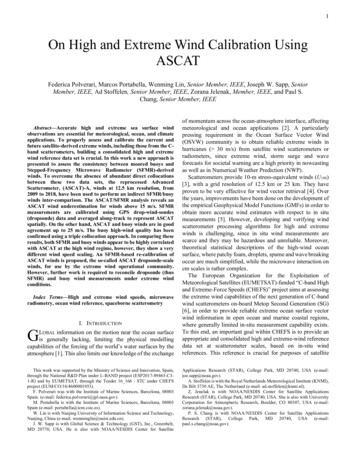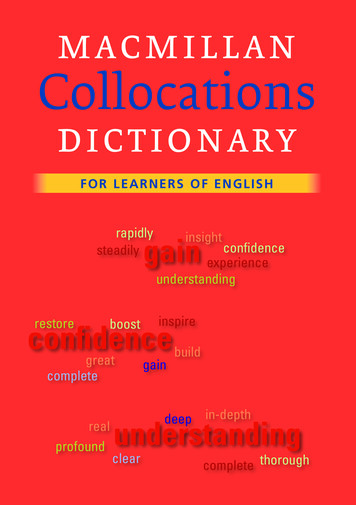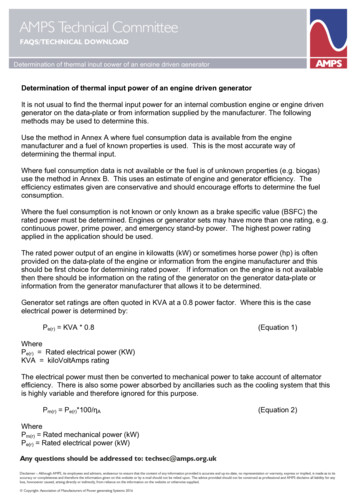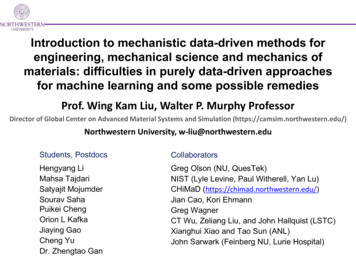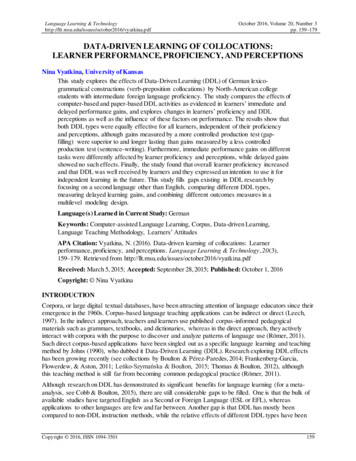
Transcription
Language Learning & atkina.pdfOctober 2016, Volume 20, Number 3pp. 159–179DATA-DRIVEN LEARNING OF COLLOCATIONS:LEARNER PERFORMANCE, PROFICIENCY, AND PERCEPTIONSNina Vyatkina, University of KansasThis study explores the effects of Data-Driven Learning (DDL) of German lexicogrammatical constructions (verb-preposition collocations) by North-American collegestudents with intermediate foreign language proficiency. The study compares the effects ofcomputer-based and paper-based DDL activities as evidenced in learners’ immediate anddelayed performance gains, and explores changes in learners’ proficiency and DDLperceptions as well as the influence of these factors on performance. The results show thatboth DDL types were equally effective for all learners, independent of their proficiencyand perceptions, although gains measured by a more controlled production test (gapfilling) were superior to and longer lasting than gains measured by a less controlledproduction test (sentence-writing). Furthermore, immediate performance gains on differenttasks were differently affected by learner proficiency and perceptions, while delayed gainsshowed no such effects. Finally, the study found that overall learner proficiency increasedand that DDL was well received by learners and they expressed an intention to use it forindependent learning in the future. This study fills gaps existing in DDL research byfocusing on a second language other than English, comparing different DDL types,measuring delayed learning gains, and combining different outcomes measures in amultilevel modeling design.Language(s) Learned in Current Study: GermanKeywords: Computer-assisted Language Learning, Corpus, Data-driven Learning,Language Teaching Methodology, Learners’ AttitudesAPA Citation: Vyatkina, N. (2016). Data-driven learning of collocations: Learnerperformance, proficiency, and perceptions. Language Learning & Technology, 20(3),159–179. Retrieved from Received: March 5, 2015; Accepted: September 28, 2015; Published: October 1, 2016Copyright: Nina VyatkinaINTRODUCTIONCorpora, or large digital textual databases, have been attracting attention of language educators since theiremergence in the 1960s. Corpus-based language teaching applications can be indirect or direct (Leech,1997). In the indirect approach, teachers and learners use published corpus-informed pedagogicalmaterials such as grammars, textbooks, and dictionaries, whereas in the direct approach, they activelyinteract with corpora with the purpose to discover and analyze patterns of language use (Römer, 2011).Such direct corpus-based applications have been singled out as a specific language learning and teachingmethod by Johns (1990), who dubbed it Data-Driven Learning (DDL). Research exploring DDL effectshas been growing recently (see collections by Boulton & Pérez-Paredes, 2014; Frankenberg-Garcia,Flowerdew, & Aston, 2011; Leńko-Szymańska & Boulton, 2015; Thomas & Boulton, 2012), althoughthis teaching method is still far from becoming common pedagogical practice (Römer, 2011).Although research on DDL has demonstrated its significant benefits for language learning (for a metaanalysis, see Cobb & Boulton, 2015), there are still considerable gaps to be filled. One is that the bulk ofavailable studies have targeted English as a Second or Foreign Language (ESL or EFL), whereasapplications to other languages are few and far between. Another gap is that DDL has mostly beencompared to non-DDL instruction methods, while the relative effects of different DDL types have beenCopyright 2016, ISSN 1094-3501159
Nina VyatkinaData-driven Learning of Collocationsunderexplored. Most studies have also investigated exclusively either learner performance outcomes orlearner attitudes. Studies that integrated multiple measures are rare. Furthermore, few studies exploreddelayed DDL effects.This study aims to fill these gaps by exploring how the productive knowledge of German verb-prepositioncollocations by North-American college students was affected by the DDL type (computer-based andpaper-based), time (pre-test, immediate post-test, and delayed post-test), task (gap-filling and sentencewriting), as well as learners’ proficiency and DDL perceptions.LITERATURE REVIEWTheoretical BackgroundThis study is grounded in usage-based language acquisition theories (e.g., Bybee, 2006; Robinson & Ellis,2008) that conceive of grammar as an abstract cognitive representation of a language that is graduallyconstructed in the learner’s mind from exposure to particular exemplars in the environment. One of themost important principles undergirding the usage-based approach adopted by corpus linguists and, morerecently, some DDL researchers is inseparability of lexis and grammar (Chambers, 2005). The main unitsof analysis in this research are linguistic constructions that can consist of concrete items (e.g., words),abstract items (e.g., word classes), and combinations thereof (Ellis, 2014). One example of such aconstruction is collocation: “the characteristic co-occurrence of patterns of words” (McEnery, Xiao, &Tono, 2006, p. 345), such as adjective-noun or verb-preposition collocations. Collocations are animportant aspect of the depth of second language (L2) knowledge (Barfield, 2013) but errors in usingthem persist even at advanced levels of L2 proficiency (Paquot & Granger, 2012). This issue has beenaddressed in DDL teaching practices and associated pedagogical principles, notably the noticinghypothesis and discovery learning (Flowerdew, 2015).The noticing hypothesis proposes that increased noticing and awareness are beneficial for adult L2learning (Robinson, 1995; Schmidt, 1990, 2001). Noticing can be facilitated by the use of two teachingtechniques: input enrichment, or repeated exposure of learners to the target structure over a period oftime, and input enhancement, or emphasizing the target structure by typographical means such as boldingand color marking (Sharwood Smith, 1993). Non-DDL research has shown that input enrichment andinput enhancement can indeed facilitate the learning of collocations, at least their recognition and recall(Sonbul & Schmitt, 2013; Szudarski & Carter, 2016). In DDL, input enrichment is realized as corporaprovide teachers and learners access to a large number of target structures in attested language usesamples, which are hard to come by in a traditional language classroom, especially in foreign languagelearning settings. Input enhancement is realized through the use of concordancers, tools for automaticretrieval of collocations, some of which are integrated with corpora and others which exist as externaltools. Concordancers supply search results as stacked lines with the search words highlighted in themiddle (see Appendix D) and thus enhance the visibility of collocational patterns.The second principle is inductive (discovery) learning (Bernardini, 2002), also associated with learnerautonomy (Gavioli, 2009). Early DDL research primarily explored the strong version of DDL, in whichlearners perused corpora directly to discover patterns of language use (with some assistance from theteacher). Although there have been several success stories involving more advanced learners, lowerproficiency learners often struggled with this approach and felt overwhelmed while working on (new) L2material with a new method and a new technology (Boulton, 2010; Gavioli, 2005). These findings haveprompted DDL researchers to create and explore modifications of DDL instructional designs that “can beplotted on a cline of learner autonomy, ranging from teacher-led and relatively closed concordance-basedactivities to entirely learner-centered corpus-browsing projects” (Mukherjee, 2006, p. 12). These DDLapproaches have been termed soft and hard (Gabrielatos, 2005) or hands-off and hands-on, respectively(Boulton, 2012). Boulton (2010, 2012), in particular, has advocated the hands-off approach in initialLanguage Learning & Technology160
Nina VyatkinaData-driven Learning of Collocationslearner encounters with corpora at lower L2 proficiency levels and in institutional contexts where handson approaches are not feasible. The research body on the effectiveness of both hands-on and hands-offDDL has been growing and is reviewed in the next section.Empirical Research on Hands-on and Hands-off DDLEmpirical DDL research has explored whether this method of instruction is effective (i.e., whether itresults in learning gains), and efficient (i.e., whether it is better than non-DDL, or mostly deductive,methods). Cobb and Boulton (2015) conducted the first meta-analysis of quantitative DDL studies andshowed that, although individual study effects tend to be small, the overall effect size for botheffectiveness and efficiency was significant and high. As regards language foci, some studies employedbroad improvement measures such as accuracy gains or the holistic quality of learner production. Otherstudies explored more specific lexico-grammatical foci and used short comprehension and productionactivities as data collection instruments (e.g., multiple-choice and gap-filling items). Studies of this lattertype that focused on DDL of L2 collocations are most relevant to this study and are reviewed below. Theoverwhelming majority of these studies have been conducted in ESL or EFL instructional contexts andhad university students at intermediate to advanced L2 proficiency levels as participants, which is typicalof DDL research in general.For hands-on interventions, significant advantages have been found for learning L2 English collocations:noun-verb collocations by first language (L1) Chinese speakers (Chan & Liou, 2005), verb-adverbcollocations by L1 Macedonian speakers (Daskalovska, 2015), and a variety of collocations by L1 Arabicspeakers (Cobb, 1997). Studies focusing on hands-off DDL interventions for teaching a variety of Englishcollocations to students with different L1s (Arabic, Portuguese, French, Thai, Chinese) found them eithersignificantly more efficient than traditional teaching methods (Frankenberg-Garcia, 2014; Koosha &Jafarpour, 2006) or equally effective with marginally higher DDL gains (Boulton, 2010; Scripicharn,2003; Tian, 2005). In a rare study that focused on L2 German, Vyatkina (2016) found that hands-off DDLwas more effective than traditional instruction for learning new verb-preposition collocations by lowintermediate L1 English learners, but both methods were equally effective for improving knowledge ofpreviously learned collocations. Additionally, several of the abovementioned studies collectedretrospective learner attitude data and reported on a generally positive perception of DDL activities by thelearners.What remains underexplored is the efficiency of specific DDL types compared to each other. Only a fewstudies focused on collocations have addressed this issue. Sun and Wang (2003) showed that inductivehands-on DDL activities led to greater gains in Chinese learners’ knowledge of easier Englishcollocations than deductive hands-on DDL activities, but there was no difference between DDL types formore complex collocations. Frankenberg-Garcia (2014) found that hands-off DDL with severalconcordance lines was not only better than traditional instruction with a dictionary but also better thanhands-off DDL with a single concordance line for teaching English collocations to L1 Portugueselearners. These two studies are significant in that they have singled out specific DDL principles that makethis type of instruction beneficial: inductive discovery and input enrichment.Another research gap is the lack of studies comparing the outcomes of hands-on and hands-off DDLinterventions, with only two recent studies tackling this issue. An exploratory case study by Yoon and Jo(2014) showed hands-off DDL to be more beneficial for the overall rate of self-correction of writingerrors by Korean learners of English than hands-on DDL, although the learners liked the hands-on methodbetter. The only quantitative study is Boulton’s (2012), who compared a hands-on and a hands-off DDLintervention teaching English verb-infinitive and verb-subjunctive collocations to intermediate collegelevel EFL learners with L1 French. Notably, Boulton also explored correlations of the productionoutcomes with learners’ proficiency and perceptions. The results showed that (a) hands-on and hands-offDDL were equally effective, (b) only hands-off performance outcomes correlated with L2 proficiency,Language Learning & Technology161
Nina VyatkinaData-driven Learning of Collocationsand (c) the correlation of learner production with perception was positive but not significant. The presentstudy aims to continue this line of research by comparing learner performance outcomes following handson and hands-off DDL and integrating proficiency and perception outcomes as well as adding the taskfactor and a delayed performance test. In order to systematically account for interactions among all thesefactors, the study employs a multilevel modeling research design. The rationale for choosing verbpreposition collocations as the target construction is discussed in the next section.The Target FeaturePrepositions, which are among the most frequent words in many languages, have been repeatedly pointedout as an area of difficulty for language learners. De Felice and Pulman (2009), for example, found that12% of all errors in a learner English corpus were preposition errors. Kennedy and Miceli (2001) calledthis problem “the fatal lure of prepositions” and exemplified it by the way L1 English learners of Italiantreated prepositions in their L2:The students’ attention was often attracted to a preposition itself rather than to the words aroundit, on which it depended. In some cases, they treated a preposition as having a meaning inisolation, or as being in one-to-one correspondence with an English preposition. (p. 83)This preferred learner approach is especially faulty in the case of prepositions that are bound to specificverbs, nouns, or adjectives. In these constructions, prepositions are closely tied to the preceding lexicalword, invariable, and semantically empty (Biber, Johansson, Leech, Conrad, & Finegan, 1999). German,like English and many other languages, has verbs that subcategorize certain prepositional arguments.However, form-meaning mappings among languages often diverge, which causes transfer errors in learnerlanguage. For example, the German equivalent of the English to wait for is warten auf (to wait on),although the prototypical translation of the preposition for is für. In a learner corpus study, Nesselhauf(2003) demonstrated a strong L1 transfer effect in the use of English collocations by L1 German learners,including noun-preposition and verb-preposition collocations.This difficulty is further exacerbated in the case of German, an inflectional language; noun phrases andpersonal pronouns that follow verb-preposition collocations must carry inflectional markers. For example,in the sentence Ich warte auf den Zug (I am waiting for the train), the inflected form of the definite articleden indicates the masculine gender, accusative case, and singular number. Furthermore, whereas the noungender belongs to the lexicon (e.g., Zug [train] is always masculine) and the number assignment dependson the context, the case (usually accusative or dative, and sometimes genitive) is assigned either by theverb or by the preposition in each specific collocation. General SLA research shows that L2 Germanlearners acquire case in such constructions fairly late, after years of instruction (Baten, 2011). This studyinvestigates whether a new method, DDL, may help tackle this complex lexico-grammatical L2phenomenon that has been refractory to traditional teaching methods.DESIGNResearch QuestionsThe following research questions (RQs) were explored: Did learner written performance improve following DDL instruction and were the gains retaineda month later? Was performance affected by task, proficiency, and perception? Which DDL method was more efficient: hands-on or hands-off? Was this effect modulated bytime, task, proficiency, and perception? Did learners’ proficiency and DDL perception change over time, and what was the relationshipbetween proficiency, perception, and time?Language Learning & Technology162
Nina VyatkinaData-driven Learning of CollocationsParticipants and Institutional SettingThe DDL intervention was incorporated into a German course taught by the researcher at a large publicNorth American university. 11 students were enrolled in the course, however, the study reports only on 10participants (five male, five female) who were present on all DDL test days. The mean age of theparticipants was 21 (ranged 18–24), and all of them had American English as their L1. Nine participantswere junior and senior university students with German as their major or minor, and one participant was aHigh School student who was taking the course for college credit. All students but one had visitedGerman-speaking countries for times ranging from several weeks to several years. The duration ofparticipants’ previous German study and their exposure to German varied, but on average, their Germanproficiency was at the B1 level according to the Common European Framework of Reference (CEFR;Council of Europe, 2001). Finally, one participant had had some previous knowledge of languagecorpora, whereas the other nine participants had none.The course was titled Advanced German I, and the class met two times a week for 75 mins over 16semester weeks (SWs). The course was oriented toward development of general proficiency in Germanand combined extensive reading, writing, discussion, and grammatical analysis activities. Beyond that,the course also aimed to develop corpus literacy (Mukherjee, 2006) by including regular hands-on andhands-off corpus assignments (similar to Boulton, 2012) constituting 30% of the total course grade.Data Collection TimelineThe data collection timeline is presented in Table 1. During the first and last lab sessions (SW1 and 15),participants filled out a DDL receptivity questionnaire and took a standardized German proficiency test.They also filled out a language background questionnaire in SW1. For the DDL experiment that suppliedperformance data for this study, all learners participated first in the hands-on condition (SW 11) and,during the next class 5 days later, in the hands-off condition (SW 12). Each experiment took one 75minute-long class period. Participants took the pre-test (ca. 10 min.) at the beginning and the post-test (ca.10 min.) at the end of class, and the 55 minutes in between were spent for the DDL interventions. In SW16, the delayed post-test was administered. There was no explicit instructional focus on the target itemsbetween the immediate and delayed post-test.Table 1. Data Collection TimelineAug. 28 (SW1)Nov. 6 (SW11)Nov. 11 (SW12)Dec. 4 (SW15)Proficiency andperception ehands-on: pre-test,treatment, andpost-testPerformanceProficiency andhands-off: pre-test, perception posttreatment, andtestpost-testDec. 9 (SW16)Performance:delayed posttestDDL Instruction ProceduresThe corpus used in the course was part of the Digital Dictionary of German (DWDS). DWDS is a largeopen access digital collection that includes, among many other corpora and corpus tools, the core corpus(Kernkorpus) of 20th century German texts and a concordancer. All participants experienced DDL bothon computer (hands-on) and on paper (hands-off) to approximately the same extent over the semester.More specifically, students completed hands-on activities during six biweekly computer lab sessions, eachtaking the whole class period. Hands-off activities were based on teacher-prepared worksheets usedduring regular class meetings. Both types of DDL work were also occasionally assigned as homework.All these activities provided the learners with ample exposure to DDL methods before the experiment,following Boulton’s (2012) approach:Language Learning & Technology163
Nina VyatkinaData-driven Learning of CollocationsThe activities themselves were typical of those discussed in DDL research, involving inductionfrom authentic concordances, sorting and interpreting data, testing and matching rules, and so on.The activities allowed learners to experience a range of typical DDL tasks: amongst other things,printed concordances featured matching and gap-fill exercises, while computer searches becamerather freer over the course. (p. 155)20 verb-preposition collocations1 (Appendix A) were selected for the study, all of them appearing in thetext of the novel that students read and discussed as the main course text (Moers, 2002) in conformitywith the principle of relevance shown to promote learning (Boulton, 2010; Hulstijn & Laufer, 2001).Furthermore, these collocations appear in common German teaching materials for intermediate toadvanced levels. All of the focal collocations had a frequency of occurrence of at least 45 per millionwords in the DWDS core corpus. Each DDL module (hands-on and hands-off) focused on one half ofthese collocations matched by their corpus frequency.Each test sheet contained sentences (Appendix B) with focal collocations from the course novel. The pretest simultaneously served as the first part of the instructional intervention. It functioned as an awarenessraising exercise as learners realized gaps in their knowledge of the focal collocations (despite repeatedexposure during years of learning German and a recent encounter in the text of the novel). Both teachingmodules followed the DDL 3 Is (Illustration-Interaction-Induction) principle (Carter & McCarthy, 1995)and also included the fourth Intervention step (Flowerdew, 2009). Following the pre-test, participantsreceived worksheets with instructions to work with DWDS concordances of the focal verbs following amodel (Illustration). Specifically, they were asked to underline the prepositional phrase following theverb, decide about the case, and to write out the verb-preposition-case collocation following a model (e.g.,warten auf accusative). Then, they were asked to compare their results with a partner (Interaction) andto come to a joint solution (Induction). The instructor then checked all results to ensure they wereaccurate (Intervention). The difference between the conditions was the following: In the hands-oncondition, learners searched the corpus for the focal verbs, read concordances, copied two examples foreach verb, and pasted them in their worksheets for analysis (Appendix C). In the hands-off condition, theworksheets supplied four to seven concordance lines for each item with highlighted verbs andprepositions (Appendix D).Data Collection Instruments and ScoringPerformanceThe testing materials for performance outcomes for each condition (hands-on and hands-off) included agap-filling task and a sentence-writing task. Each pre-test and immediate post-test included 10 gap-fillingitems and five sentence-writing items with five pre-assigned verbs randomly selected from the gap items.On the pre-tests, sentences with bolded focal verbs and gaps for focal prepositions were arranged in thesequence they appeared in the novel, and on the post-tests, they were scrambled (see Daskalovska, 2015).The delayed post-test included all 20 items from both treatment conditions with sentences following theorder they appeared in the novel and all 10 verbs used in previous tests for sentence writing in a randomorder. In the gap-filling part, each accurately supplied preposition earned one point. In the sentencewriting part, each accurately supplied preposition earned one point and each accurately supplied inflectionafter each accurately supplied preposition earned one point. Therefore, the maximum number of pointseach learner could earn was 10 per test, per condition, per task.ProficiencyParticipant L2 proficiency was measured twice, in SW1 and SW16, during the regularly scheduled labhour, with an official online diagnostic test administered by the onDaF Institute in Bochum, Germany,and proctored at the researcher’s institution. Upon completion of this 40-minute-long cloze test,participants earned a certain number of points equivalent to the number of correctly filled gaps and wereLanguage Learning & Technology164
Nina VyatkinaData-driven Learning of Collocationsautomatically placed within CEFR bands (Eckes & Grotjahn, 2006). The descriptive statistics for theproficiency outcomes are presented in Table 2. It shows that prior to the course, the average L2proficiency was slightly below the onDaF core range values for the B1 CEFR level (75–80), whereas afterthe course, it was slightly above that core range. Only post-course proficiency outcomes (available for all10 participants) were used to answer RQ1 and RQ2, whereas temporal proficiency changes wereaddressed in answering RQ3 using proficiency outcomes for the nine students who completed both thepre-test and post-test.Table 2. Descriptive Statistics for Proficiency OutcomesonDaF TestNMMinMaxSDN in CEFR 704811822.941B14B2263PerceptionDDL perception data were collected by means of a written pre-course and a post-course receptivityquestionnaire that partially replicated Boulton’s (2012, p. 161) questionnaire and in which learners ratedtheir expectations and satisfaction regarding DDL activities on a 5-point scale (Table 3). Only post-courseperception outcomes are used to answer RQs 1 and 2, whereas temporal changes are addressed inanswering RQ3. Additionally, as part of a cumulative final course assignment, students wrote open-endedcommentaries about their experiences with DDL.Table 3. Descriptive Statistics for Perception (Receptivity) OutcomesReceptivity to Corpus Use123The German corpus (DWDS) will be / has been easy to usefor language learning purposes.The German corpus (DWDS) will be / has been useful forlearning German.Corpus work will be / has been interesting.4I liked doing corpus activities on computer.5I liked doing activities with corpus concordances on paper.Overall .81.431.140.22Note. Questions adapted in part from Boulton (2012, p. 161).RESULTSResearch Question 1Did learner written performance improve following DDL instruction and were the gains retained a monthlater? Was performance affected by task, proficiency, and perception?First, the pre-test and post-test performance scores of each of the 10 participants were inspected usingsimple counting. This analysis showed that nine of them improved their performance on the immediatepost-test. Only one learner scored 15 points on the immediate post-test in comparison with 16 on the pre-Language Learning & Technology165
Nina VyatkinaData-driven Learning of Collocationstest in the hands-on condition, and the same learner scored 11 points on both the pre-test and immediatepost-test in the hands-off condition. Further inspection showed that this lack of improvement was due toher performance only on sentence-writing items, whereas she improved on the gap-filling items.Furthermore, another learner scored 2 points lower on the immediate post-test than on the pre-test onsentence-writing items. Finally, all learners scored lower on the delayed post-test than on the immediatepost-test but higher than on the pre-test, with only the same two learners who lacked improvement on theimmediate post-test falling slightly below their pre-test scores on the delayed post-test.Next, learner performance outcomes were explored statistically using multilevel regression models, whichhave been recently acknowledged as a preferred method in SLA research in comparison with moretraditional ANOVA methods (Cunnings, 2012). The descriptive statistics are summarized in Table 4 andpre- to post-test changes are illustrated in Figure 1. One can see that the average pre-test knowledge waslower than 50% (out of 10 possible points) per each test task. Following the DDL modules, all outcomesincreased on the immediate post-test and decreased on the delayed post-test, although not to the level ofthe pre-test.Table 4. Descriptive Statistics for Performance psentencehands-offPost-testDelayed 162.582.412.57Figure 1. Average raw test scores by time, treatment method, and task.Choosing the Method and Fitting the ModelTo explore whether these changes were significant and how they were affected by task, learnerproficiency, and learner perception, multilevel Poisson regressions were applied to the raw test scorestreating them as counts and using z-tests associated with each parameter and test. This method was chosenbecause the raw test scores were not normally distributed. The values for the performance scores(dependent variable) at repeated measurements (Level-1) were nested within individual students (Level-Language Learning & Technology166
Nina VyatkinaData-driven Learning of Collocations2), and the values for task, proficiency, and perception were factored in as predictor variables in additionto time. Because zero was outside the range of observed values for both proficiency and perception, theywere both centered at their grand means to help interpret the other parameters. Post-test proficiencyvalues were divided by 10 so that their scale was more similar to other variables, which helped the modelsconverge on a solution.In the initial model, proficiency and perception were both allowed to interact with time of measurement,which significantly improved the model with only time as a predictor of gap-filling scores (χ 2 (6) 22.26,p .001). But adding t
errors by Korean learners of English than hands-on DDL, although the learners liked the hands-on method better. The only quantitative study is Boulton's (2012), who compared a hands-on and a hands-off DDL intervention teaching English verb-infinitive and verb-subjunctive collocations to intermediate college-level EFL learners with L1 French.
